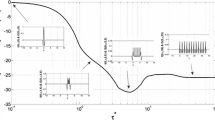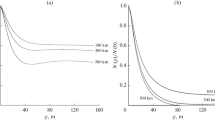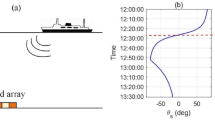Abstract
Seismic arrays are commonly used to enhance vertically traveling signals and attenuate horizontally traveling noise. However, variations within the array length can degrade the array response. This paper studies the effect of a dipping shallow layer across the array length on the array response, by modeling plane Ricker wavefronts incident on 12-element equally and triangularly weighted arrays. To analyze the dip effect, shallow layer dip angles of 0°, 15°, 30°, and 45° are used, while wavefront incidence angles of 90°, 70°, 45°, 20°, and 5° are used to analyze the effect of dip on various types of signals and noises incident on the array. In the presence of a dipping shallow layer, an array designed to attenuate a wave with a certain dominant frequency will actually attenuate a wave with a different frequency, so degrading the array performance. The effects of incidence and dip angles on the array response are opposite. The degradation in the array performance depends largely on the combination of incidence angle of the targeted signal and shallow layer dip angle. However, the degradation in the array response became more severe as the incidence angle decreased. Thus, vertically incident signals are more severely affected than horizontally incident noise (e.g., ground roll). A spatial filter to compensate for these effects is proposed, which requires knowledge of the incidence and dip angles. Since a dipping bottom boundary of the shallow layer cannot be inferred from the surface topography, it can affect the array response without being detected. Therefore, the dip of the shallow layer bottom should be estimated prior to array layout. Once the dip angle is known, a spatial filter can be designed to account for the effects of incidence and dip angles.
Similar content being viewed by others
References
Kearey P., Brooks M., Hill I.: An Introduction to Geophysical Exploration. Blackwell, Oxford (2002)
Aldridge D.F.: Statistically perturbed geophone array responses. Geophysics 54, 1306–1318 (1989)
Marsden D.: Static corrections: a review. Lead. Edge 12, 43–49 (1993)
Smith M.K.: Noise analysis and multiple seismometer theory. Geophysics 21, 337–360 (1956)
Newman P., Mahoney J.T.: Patterns—with a pinch of salt. Geophys. Prospect. 21, 197–219 (1973)
Gangi, A.F., Benson, M.A.: The wavelet response of seismic arrays. In: 59th Annual International Meeting, Society of Exploration Geophysicists, Expanded Abstracts, pp. 663–666 (1989)
Johnson D.H., Dudgeon D.E.: Array Signal Processing—Concepts and Techniques. Prentice-Hall, Englewood Cliffs (1993)
Al-Shuhail, A.A., Gangi, A.F.: The effect of topography on the wavelet response of seismic arrays. In: 64th Annual International Meeting, Society of Exploration Geophysicists, Expanded Abstracts, pp. 895–898 (1994)
Sayers C.M.: Determination of anisotropic velocity models from walkaway VSP data acquired in the presence of dip. Geophysics 62, 723–729 (1997)
Hoffe B.H., Margrave G.F., Stewart R.R., Foltinek D.S., Bland H.C., Manning P.M.: Analyzing the effectiveness of receiver arrays for multicomponent seismic exploration. Geophysics 67, 1853–1868 (2002)
Panea I., Drijkoningen G.: The spatial data-adaptive minimum-variance distortionless-response beamformer on seismic single-sensor data. Geophysics 73, Q29–Q42 (2008)
Panea, I.: The use of array-forming with or without other filters applied on seismic single-sensor data. In: 71st Conference of the European Association of Geoscientists and Engineers (2009)
Strobbia, C.L., Glushchenko, A., Laake, A., Vermeer, P.L., Papworth, G., Li, Y.: Point receiver acquisition and processing for Arctic near-surface challenges. In: 71st Conference of the European Association of Geoscientists and Engineers (2009)
Panea I.: Array forming in the presence of phase variations. Lead. Edge 28, 216–221 (2009)
Ricker N.: The form and laws of propagation of seismic wavelets. Geophysics 18, 10–40 (1953)
Costain J.K., Coruh C.: Basic Theory of Exploration Seismology. Elsevier, Amsterdam (2004)
Sheriff R.E., Geldart L.P.: Exploration Seismology. Cambridge University Press, Cambridge (1995)
Author information
Authors and Affiliations
Corresponding author
Rights and permissions
About this article
Cite this article
Al-Shuhail, A.A. Seismic array response in the presence of a dipping shallow layer. SIViP 7, 263–274 (2013). https://doi.org/10.1007/s11760-011-0234-8
Received:
Revised:
Accepted:
Published:
Issue Date:
DOI: https://doi.org/10.1007/s11760-011-0234-8




